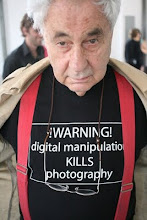STOPPELMAN, Francis and Salvador Novo.
México en Movimiento / Mexico on the Move.
Leiden: Nederlandse Rotogravure Maatschappij, 1970. First Edition. Quarto. Photographs by Dutch photographer Francis Stoppelman, with introductory text in Spanish and English by Salvador Novo. Numerous gravure illustrations of late sixties Mexico, with a few color spreads interspersed. Stoppelman's images of modernization and industry are the strongest in this curious book about Mexico of which little is known.
See also
America: a journey through injustice Enrique Bostelmann Latin American Photobook Photography
Frans Stoppelman (* 9 January 1921, Amsterdam, Netherlands; died 23 October 2007 in Mexico City, Mexico) was a Dutch photographer.
Frans Stoppelman, also known as Francis Stopelman, was born in Amsterdam. His father was a textile merchant. With detergent stamps he bought his first camera, a Kodak Brownie. He ran away from home after his mother's death and a dispute with his stepmother. He dropped out of school and drifted through odd jobs.
During the World War II, he was forced to flee as a Jew from the Netherlands. After an adventurous journey, he arrived in Switzerland on 13 April 1942. He was interned in a labour camp in Les Verrières. There he did his first photo reportage, which is now in the possession of the Jewish Historical Museum in Amsterdam. He was allowed to enter a training at a photo Academy in Lausanne. As a press photographer after the war, he remained in Switzerland.
In 1949 he went to Chile. For many years he photographed children in swimming pools. His sense of bizarre situations brought him international success. A photo that shows people huddling around the first escalator installed in the capital city of Santiago, was published by life magazine.
Numerous orders from time to time brought him to Europe, so he returned to Amsterdam at the end of the 1950s. He declined a professorship at the Royal Academy of Fine Arts in the Hague. He preferred to return to his archives, which he had left in Chile.
In the 1960s, he settled down in the Caribbean, where he wandered, wrote some books and otherwise lived day to day. In 1968, he travelled to Mexico on the occasion of the Olympic Games. He remained there until the end of his life.
Uitgaven van de Nederlandsche Rotogravure Maatschappij
In 1913 werd in Leiden de Nederlandsche Rotogravure Maatschappij opgericht. Voor dit diepdrukprocédéwerd de drukpers uitgerust met koperen cylinders; het af te drukken vlak ligt verdiept in de drukplaat. De overtollige inkt werd door 'rakels' weggestreken.
Met voorlopers van deze techniek konden wel afbeeldingen worden gedrukt, maar geen teksten. In 1910 patenteerden de Duitsers August Nefgen en Ernst Rolffs een uitvinding om beide te combineren in rasterdiepdruktechniek.
De nieuwe vinding werd ook in Leiden al snel toegepast, dankzij een licentiecontractmet de Deutsche Photogravure AG. Daardoor kon de NRM als enige in Nederland het procédé gebruiken. De resultaten werden voor iedereen zichtbaar in de eerste aflevering van het tijdschrift Panorama.
Vanaf 1918 kon de NRM ook in kleur drukken. In 1931 verscheen een reclame-uitgave, geschreven door directeur Levie Levisson: Licht en donker. Hierin werd het procédé toegelicht in tekst en afbeeldingen.
Een beroemd - en speels - voorbeeld van het rotogravureprocédé is een door Piet Zwart vormgegeven reclame-uitgave voor het post- en telefoonbedrijf: Het boek van PTT. Het werd in 1938 speciaal voor de jeugdgedrukt in vier kleuren. Tekst en beeld waren geïntegreerd, waarbij Zwart combinaties maakte van tekeningen, kleurenfoto’s (onder andere van speciaal vervaardigde poppen), zwart-wit foto’s, fotomontages en moderne asymmetrische typografie.
(Paul van Capelleveen)
Beschrijving:
L. Levisson, Licht en donker. Leiden, Nederlandsche Rotogravure Maatschappij, 1931. Aanvraagnummer: 2299 F 102.
Getoond met:
Het boek van PTT. Samengesteld door Piet Zwart. Leiden, Nederlandse Rotogravure Mij. 's-Gravenhage, Rijksuitgeverij, 1938.Aanvraagnummer: 1107 C 86.
en:
Panorama. Geïllustreerd weekblad in koperdiepdruk. Jrg. 1, nr. 1 (2 juli 1913). Aanvraagnummer: 2281 A 131.







































Geen opmerkingen:
Een reactie posten